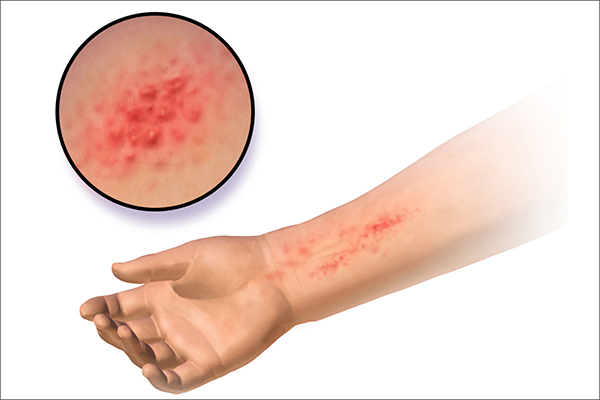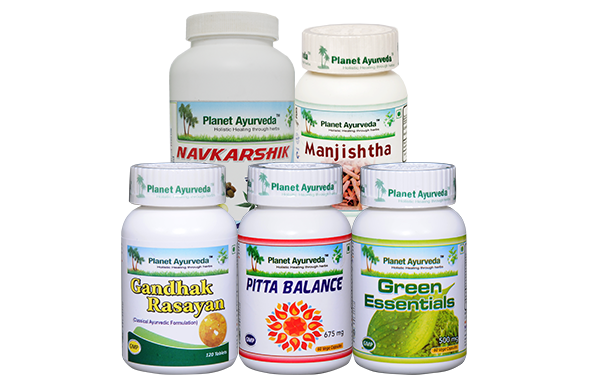Ayurvedic Treatment for Dermatosis
Abstract
Dermatosis Papulosa Nigra (DPN) is a rare skin condition in which appearance of benign small lesions particularly on the face is observed. These are present on and around the forehead cheekbones and also under the eyes. The appearance of such lesions is also seen in back, neck and chest regions. Dermatosis Papulosa Nigra mostly affects dark pigmented skin and particularly common in females rather than males. This condition is generally observed in teenagers and can also develop in adults due to many reasons. Dermatosis is also called as sweet syndrome and acute febrile neutrophilic dermatosis. In this article we will discuss the causes, symptoms, diagnosis, treatment and also the ayurvedic perspective of the condition.

Introduction
In ayurveda all the skin diseases are related to kushta and its sub types. Dermatosis, in the same way can be understood as a type of kushta and is best related with rshya jihva. Dermatosis is also associated with many types of cancers as an associated symptom. Dermatitis and dermatosis are generally confused with each other but the basic difference between the both is that, in dermatosis skin develop lesions and dermatitis is the result of dermatosis. This condition is quite typical and needs to be diagnosed on time.
Causes
Generally the cause of dermatosis is not known in modern science. The condition is usually seen associated with immunocompromised conditions like different types of cancers like colon cancer, breasts cancers, solid tumors etc. It may also occur as a reaction to the medication that produces white blood cells.
If we talk about the causes of kushta in ayurveda then habitual intake of incompatible food items and liquids, unctuous and heavy substances, suppressing natural urges particularly vomiting and exposure to intense heat are the commonest causes of kushta.
The factors influencing the risk to develop this condition includes sex (mostly females are affected), age (teenagers and adults are commonly affected, even infants can develop this condition rarely), patients with cancer conditions, upper respiratory tract infections, pregnancy and sensitivity to drugs like azathioprine.
Symptoms
The symptoms for rishya jivha kustha includes
![]()
(ch. Chi. 7/17 )
- Karkash (rough)
- With red margins
- Internally blackish
- Painful and similar to the tongue of rishya in appearance.
According to modern medicine fever along with painful lesions are the commonest symptoms. These bumps or lesions can grow quickly in size and spread, forming a painful cluster which can reach upto 2.5cm in size.
Diagnosis
An expert in skin conditions can diagnose sweet syndrome very easily but still there is a need to perform some tests like blood tests for detecting the count of white blood cells which are present in large numbers in this condition and skin biopsy of affected tissue.
Treatment
The most commonly used medications for the treatment of this condition is corticosteroids. Administration of corticosteroids like prednisone is generally prescribed and long term use of these medications can cause side effects like weight gain, insomnia and weak bones. Steroidal creams and ointments are also used on the affected parts but these creams can result in skin thinning. Another option includes injecting a corticosteroid directly into the lesion but in case of multiple lesions this is of no use.
In ayurveda it is stated that the patient of kushta having more than one dosha should be evacuated frequently taking care of his or her strength because excessive elimination of doshas vitiates vata and ruins the body of weak patients. When bowels are evacuated and blood is let out an intake of ghrita is prescribed because in weak patients after evacuation vata prakopa takes place easily.
Sushruta has also mentioned the use of medicated emesis, medicated purgation, avpeedan nasya and rakta mokshana frequently.

(Su. chi. 9/43)
Most importantly, nidana parivarjana is to be done. For internal use some classical medications like shudha gandhak, gandhak rasayan, arogyavardhini vati, khadirarishta etc. are commonly given.
For the management of dermatosis planet Ayurveda which is a leading herbal manufacturing unit offers some of its formulation which can be very beneficial in improving the condition of a dermatosis patient. The herbal formulations are as follows:
Products Description
1. Gandhak Rasayan
It is prepared using shuddha gandhak along with some vital herbs like amalaki (Emblica officinalis), vibhitaki (Terminalia bellerica), haritaki (Terminalia chebula) and many others. The components of gandhak rasayan have many properties like they are antiviral, antibacterial, antimicrobial, antipruritic, and anti-inflammatory. The use of these tablets regularly helps in treating several skin conditions like itchiness, fungal infections, and reduces acne and pimples. It helps in balancing pitta and purifies blood.
Dosage: Two tablets twice daily after meals.
2. Pitta Balance
Pitta Balance are manufactured using herbal components like praval pishti (coral calcium), mukta pishti (pearl calcium), jawar mohra pishti and many more. These capsules help in balancing pitta dosha which is believed to be the primary cause of this condition. It also supports healthy digestion and reduces accumulation of ama which is responsible for pitta vitiation.
Dosage: One capsule twice a day after meals.
3. Manjishtha Capsules
The capsules contain standardized extract of manjishtha (Rubia cordifolia). These capsules are best for detoxifying blood and also balances pitta and partially vata. They help in reducing inflammation caused due to dermatosis and relieves pain. It also helps in enhancing immunity in immunocompromised patients.
Dosage: One capsule twice a day after meals.
4. Green Essentials
Green essentials help in enhancing immunity, detoxifies liver and blood and also help in production of healthy blood cells. It also acts as a digestive formulation as it contains triphala amalaki (Emblica officinalis), vibhitaki (Terminalia bellerica), haritaki (Terminalia chebula). This is a very good formulation to free your body from radicals that causes damage.
Dosage: One capsule twice a day after meals.
5. Navkarshik Churna
The herbal formulation has triphala amalaki (Emblica officinalis), vibhitaki (Terminalia bellerica), haritaki (Terminalia chebula) along with neem (Azadirachta indica), giloy (Tinospora cordifolia) and many other herbs. These herbs are very potent in balancing vata and pitta both. Navkarshik churna is very much effective in skin disorders due to blood toxification as it purifies blood also.
Dosage: One teaspoon of churna with lukewarm water twice a day after meals.
Contact Planet Ayurveda to provide you the costing / ordering and delivery information at – costing.planetayurveda@gmail.com or call at +91-172-5214030 Or Check Website – www.PlanetAyurveda.com
Conclusion
Dermatosis is a skin condition which is manageable if it is diagnosed on time. In ayurveda this condition is understood as krichasadya (difficult to treat) due to the involvement of vata and pitta both. The medications offered by planet Ayurveda are potential in managing this condition and show good results if taken under the guidance of expert physicians. The herbal formulations do not cause any side effects and are free from adulterants. For any query kindly visit www.PlanetAyurveda.com
Dr. Vikram Chauhan
Latest posts by Dr. Vikram Chauhan (see all)
- Best Herbs That Kill Cancer Cells - December 12, 2023
- How to treat optic neuritis in ayurveda with herbal remedies - December 11, 2023
- Treatment of Sarcoidosis in Ayurveda with Herbal Remedies - November 20, 2023
- Vibhitaki/Baheda (Terminalia bellirica)- Benefits, Medicinal Uses, Dosage & More - November 18, 2023
- Chylous Ascites Causes Symptoms and Treatment in Ayurveda - October 4, 2023






